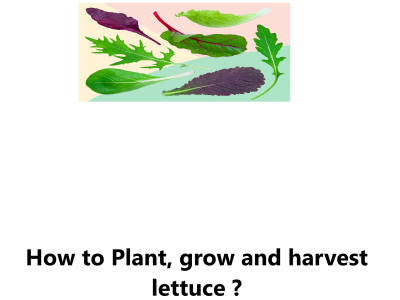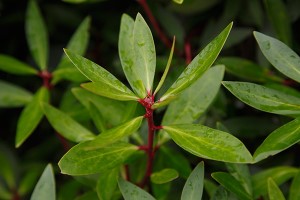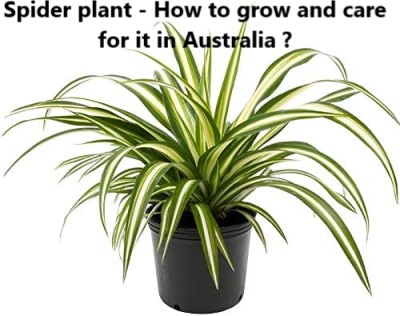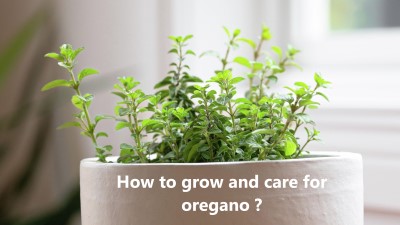- Houseplants
- 3,251
Lettuce is a popular leafy green for salads, sandwiches, wraps, and more. Not only is it delicious and versatile, but growing and caring for lettuce is surprisingly easy and rewarding.
Here at Garden Pie, we shall look into how to grow and care for lettuce.
Table of contents [Show]
- 1 What you need to know about growing and caring for lettuce
- 2 Appearance and characteristics of lettuce
- 3 Uses for lettuce
- 4 How to plant and grow lettuce from seeds ?
- 5 Caring for lettuce plants
- 6 How often should you water and feed lettuce ?
- 7 Diseases and pests affecting lettuce
- 8 How to propagate lettuce ?
- 9 How and when to harvest lettuce ?
- 10 Safety tips after planting lettuce
What you need to know about growing and caring for lettuce
Growing and caring for lettuce is easy and rewarding. Whether you want to grow your own lettuce in a container in your backyard or you’re planting lettuce in an urban farm, there are several important things you need to know before you get started.
First and foremost, you should determine the type of lettuce you want to grow. There are a variety of lettuce types including leaf, Romaine, and what is called heading lettuce. Leaf lettuce grows in a loose, open head, while Romaine and heading lettuce form a tight, dense head.
Romaine and heading lettuce are great for slicing and using as a salad base, or for serving as wedges to top a salad. Leaf lettuce is perfect for blending into salads, layering into sandwiches, and using as a topping for burgers.
When you're ready to plant, you should use either seedlings or seeds. Planting seedlings will provide a quicker crop that can be ready for harvest earlier than if you were to start from seeds. Seeds, however, are ideal for those who want to create their own unique blend of lettuce. With either option, you should keep in mind the space requirements for your plants.
Once your lettuce is planted, you should monitor the water. Lettuce prefers soils that are well-drained and slightly moist. Be sure to provide supplemental water as needed throughout the season, as dry soil can prevent your lettuce from forming heads.
As your plants begin to grow, it's important to keep them weeded. Weeds compete with your lettuce for nutrients and space, and can potentially stunt the growth of your plants. Mulching around your lettuce can help keep weeds at bay.
Once your lettuce is ready for harvest, you should use a sharp knife or scissors to cut the leaves at the base. Be sure to handle the lettuce gently, as it can bruise easily.
Facts about lettuce includes:
- Name: lettuce, cos lettuce, head lettuce, loose-leaf lettuce, butter lettuce, romaine, Lettuce sativa.
- Height: 15–40 cm.
- Foliage: Annual plants with green or red foliage.
- Climate: All climates and areas, but needs protection from heavy frost.
- Soil: incorporate compost and decomposed manure into the soil. An alkaline pH is best.
- Position: prefers a partially shaded area, but can also grow in full sun during autumn and winter.
- Feeding: not necessary if soil is properly prepared beforehand.
- Watering: Keep up with regularly watering, especially in arid or temperate climates. Ensure the soil does not dry out completely but don't overwater in humid environments.
Appearance and characteristics of lettuce
Lettuce is an attractive plant. Depending on the variety, the leaves can range from yellowish-green to deep purple.
Different types of lettuce also vary in their leaf shape - they can be ruffled or smooth, lobed or round, and divided or entire. The flowers vary depending on the variety, too. The most common are clusters of small, yellow blooms.
The most common types of lettuce are ‘Butterhead’ and ‘Iceberg’ - both of these have large, soft leaves. They are generally low maintenance plants and grow best in rich, moist soil with full sun exposure. They can grow in partial shade as well, but may become leggy or produce fewer leaves.
These types of lettuce are generally fast-growing and have a short harvest window. They can be planted year-round, as long as the temperatures are not too cold. Lettuce is also fairly cold-tolerant, and some varieties can handle temperatures down to 10 degrees Fahrenheit (-12 degrees Celsius).
In addition to the common varieties, there are a few unique types of lettuce worth considering. Species like Lactuca virosa (wild lettuce) and Lactuca serriola (prickly lettuce) are both edible and can add a unique flavor to salads.
Uses for lettuce
Lettuce is a healthy vegetable that is commonly used in salads, sandwiches, tacos, and wraps. But did you know that lettuce can be used for more than just its standard uses ? In fact, there are a multitude of ways to use lettuce in various recipes and even as a beauty aid.
First and foremost, lettuce is a great source of nutrition. It contains essential vitamins and minerals such as vitamin A, C, and K, as well as calcium, folate, and fiber. Eating lettuce can help you meet your daily needs for these nutrients. Moreover, lettuce can help you lose weight due to its low-calorie content.
Beyond the nutrition benefits, lettuce can be used in a variety of recipes. For example, lettuce can be added to smoothies to give them some texture and flavor. Or, if you want to add some crunch to your salad or sandwiches, try adding some lettuce leaves. For a light meal, lettuce can also be used to make wraps with lean proteins such as tuna, chicken, or turkey.
In addition to being used in recipes, lettuce can also be used as a beauty product. For example, you can make a homemade face mask by mixing two parts mashed avocado and one part finely chopped lettuce.
The nutrients in the lettuce can help nourish and hydrate the skin while the avocado will provide some moisture. Furthermore, you can make a homemade bathing salt by adding 2 tablespoons of grated lettuce to a cup of Epsom salt. The lettuce will help hydrate and soften the skin during your bath.
How to plant and grow lettuce from seeds ?
1. Select a Site: Lettuce prefers well-draining, rich soil and direct sunlight for 6 to 8 hours a day. Choose a spot that is relatively weed-free and has few roots, rocks, or other debris.
2. Prepare the soil: Before you plant, till or loosen the soil to a depth of 6 inches. Work in a generous helping of compost or manure to provide nutrients and improve soil structure.
3. Choose the Right Lettuce Seeds: There are many varieties of lettuce to choose from, so you can pick the one that best suits your needs. Some varieties are more heat-tolerant and will do better in warm climates, while others are more cold-tolerant and perform better in cooler climates.
4. Plant the Seeds: Lettuce seeds are small and should be sown 1/4 to 1/2 inch deep. When planting, keep in mind that most lettuce varieties don't do well when planted close together. Space the seedlings at least 4 to 6 inches apart to give them enough room to develop.
5. Water and Fertilize: Once the seeds are planted, water them lightly and cover them with a thin layer of soil. Once the seedlings emerge, water them every 7 to 10 days and fertilize them every two weeks with a balanced fertilizer.
6. Thin the Lettuce: Once the seedlings are a few inches tall, you should thin them out leaving only the strongest plants. This will give the remaining plants more room to grow and develop.
7. Monitor and Harvest: Monitor your lettuce carefully for signs of wilting, disease, or pests. Harvest the heads of lettuce when they are still young and tender, and try to harvest the entire plant at once.
Caring for lettuce plants
When growing lettuce indoors, it is important to provide the plants with full or partial sunlight throughout the day. This helps the plants grow and develop good flavor.
When planting seedlings, dig small furrows about an inch deep and space the plants two to three inches apart. It is important to keep the soil in the area moist and water regularly.
When caring for your lettuce plants, make sure to fertilize them with a balanced fertilizer once every couple of weeks. This will give your plants the necessary nutrients to grow and develop tender leaves. Also, when harvesting your lettuce it is best to pick them when they are young to ensure the best flavor.
To help keep pests away from your lettuce plants, consider planting companion plants like onions, chives, radishes or garlic around the lettuce plants. This can help deter aphids, snails and other insects that like to feed on award lettuce.
Finally, to promote healthy growth and prevent diseases, rotate your lettuce plantings every season so new plants don't get diseases that may have been left behind in the soil from the previous season. This is especially important for lettuce plants that are grown indoors since diseases can spread quickly in these close quarters.
How often should you water and feed lettuce ?
To ensure your lettuce is of the highest quality, it is important to know the proper care for your lettuce plants. So, how often should you water and feed your lettuce ?
When it comes to watering your lettuce, it is essential to ensure that the soil is not completely saturated. Too much water can lead to the lettuce rotting since it doesn’t have enough drainage.
Depending on the time of year and climate, plan to water your lettuce about once every five to seven days. You can adjust this more or less depending on how quickly the soil dries out.
When it comes to feeding your lettuce, you should be doing so about every two to four weeks. Lettuce is a light feeder, meaning that it doesn't need very much fertilizer.
You can use a balanced liquid fertilizer and follow the instructions on the packaging for the correct application rate.
Diseases and pests affecting lettuce
Unfortunately, lettuce can also be affected by a variety of diseases and pests that can cause significant damage and decrease yields. It is important to be aware of the potential threats and to know how to combat them effectively.
Diseases
There are several diseases that can affect both the leaves and the roots of lettuce. One of the most common lettuce diseases is downy mildew which is caused by the fungus Peronospora parasitica. Symptoms of downy mildew include yellow spots on the underside of leaves and white fuzz on the tops. The disease can be treated by rotating crops and using disease-resistant varieties. Additionally, fungicides can be used to treat infected plants.
Pests
There are a variety of pests that can affect lettuce crops as well. Some of the most common include aphids, caterpillars, slugs, and snails. Aphids can suck the sap from the plant and cause deformed leaves. They can be controlled using predatory insects or insecticides. Caterpillars feed on the leaves and stems, resulting in damage. Controlling caterpillars can be done using pheromone traps or insecticides. Slugs and snails will also eat the leaves, but can be controlled by trapping them or with organic slug and snail pellets.
Prevention and Control
There are several ways to prevent and control diseases and pests affecting lettuce. A proper fertilization plan can help to keep the plants healthy and create an environment that is less conducive to disease and pests. Rotating crops and using disease-resistant varieties can also help reduce the risk of disease. Caution should also be used when purchasing plants, as infected plants can spread the disease. Finally, monitoring for signs of pests and diseases and treating them early is important in preventing them from escalating and causing mass destruction.
How to propagate lettuce ?
There are a variety of methods for propagating lettuce, which range from conventional seeds to modern cloning techniques. Despite the many different techniques, each has the same goal: to produce healthy, strong lettuce plants. Whether you’re a beginner or an experienced gardener, propagating lettuce can be an exciting and rewarding experience.
1. Seeds Propagation
The most common method for propagating lettuce is to use seeds.
- Start by purchasing lettuce seeds from a local garden center or nursery, as well as a seed starting mix from the same.
- Fill your seed containers or small pots with your seed starting mix and sow 2-3 seeds in each container.
- Press the seeds lightly into the soil, without covering them.
- Then, water your pot until the soil is moistened.
- Place the containers on a warm windowsill, in a greenhouse, or even outside.
- When the seeds germinate, thin out the weakest seedling and leave the healthiest.
2. Clonal Propagation
Another propagation method is known as clonal propagation, which involves taking cuttings from a “mother” lettuce plant.
To do this:
- Choose a healthy lettuce plant that is free of diseases, pests, and weeds.
- The ideal cutting will be one that is actively growing and has no flower buds.
- Cut off young shoots about 3-4 inches long, once the roots have appeared.
- Place the cuttings in a rooting hormone before planting in a separate pot.
- Keep the soil moist and regularly water the cuttings to promote growth.
3. Root Division
Finally, propagate lettuce using root division. This method is best used on older lettuce plants that have multiple stalks or runners.
- Carefully dig up the entire plant and separate the stalks.
- Replant each of the sections and water them thoroughly.
- Regular watering is essential for root division to succeed; otherwise, the new plants may dry out and fail.
How and when to harvest lettuce ?
Harvesting lettuce is a fun and rewarding experience for gardeners and you can easily do it at home. Knowing when and how to harvest lettuce is key for getting the most out of your harvest.
Here are some tips on how and when to harvest lettuce.
When to harvest lettuce:
- The best time to harvest lettuce is when the leaves are full-sized, but still tender and crisp.
- Depending on the variety you are growing, you should begin harvesting lettuce approximately 60 days after seeding.
- Most leaf lettuce varieties can be harvested in 40-45 days, while head or butterhead types may take a bit longer.
- To harvest the leaves, gently grab the leaves near the base of the plant and pull away from the stem.
How to harvest lettuce:
When harvesting lettuce, it is best to grab the leaves near the base of the plant and pull away from the stem.
If you are harvesting head or butterhead lettuce, use a sharp knife to cut the entire head off at the base of the stem.
If the leaves are too large to be eaten as a complete head, you can cut them into desired sizes.
You should also remove any damaged or diseased leaves as you harvest to avoid the spread of pests or disease.
Once you have harvested the lettuce, it is important to use it as soon as possible since lettuce will quickly spoil in warmer weather.
Safety tips after planting lettuce
Gardening is a great activity for many people, and planting lettuce is no exception. There are a few safety tips that should be kept in mind when planting lettuce to ensure a successful crop and safe gardening experience.
First and foremost, safety gear is essential. This includes gloves, goggles, and a dust mask to protect from breathing in dust while tilling and prepping the soil. Loose clothing and open-toed shoes should be avoided as they can easily become caught in the gardening tools.
Another safety tip to keep in mind is to create a safe distance between yourself and the tools. If you're using a tiller, for example, keep your hands and feet away from the blades. Additionally, never try to reach to the other side of the tiller while it's running as this could result in serious injury.
When planting, it's important to be mindful of the tools being used. If you're using a hoe, keeping the blade close to the soil and never letting go of the shaft will help to maintain control. When using a shovel, it’s important to take frequent breaks as well as using proper lifting techniques to minimize the risk of injury.
Last but not least, it's important to plan your garden ahead of time, so you know what to expect from the process ahead of time. Before planting, take some time to read up on the appropriate planting methods and to understand the effects that watering, sunlight, and soil conditions can have on your lettuce crop.
Conclusion
Growing lettuce is a rewarding experience that can be enjoyed by people of all ages. It is a relatively easy crop to grow, and it can be enjoyed fresh from the garden or stored in the refrigerator for later use.
By following the simple steps outlined in this guide, you can be sure to enjoy a bountiful harvest of fresh lettuce all season long.
Here are some additional tips to help you grow lettuce successfully:
- Choose the right variety. There are many different varieties of lettuce, so choose one that is suited to your climate and growing conditions.
- Plant at the right time. Lettuce is a cool-season crop, so it is best to plant it in the spring or fall.
- Prepare the soil. Lettuce prefers a well-drained soil that is rich in organic matter. Before planting, amend the soil with compost or manure.
- Water regularly. Lettuce needs regular water, especially during hot, dry weather. Water deeply so that the roots can reach moisture.
- Fertilize occasionally. Lettuce does not need a lot of fertilizer, but you can fertilize it with a light application of compost tea or fish emulsion every few weeks.
- Protect from pests and diseases. Lettuce is susceptible to a number of pests and diseases, so it is important to take steps to protect your plants. You can do this by planting resistant varieties, rotating crops, and controlling pests and diseases with natural methods.
21 tips to keep lettuce safe from pests and diseases.
To keep your lettuce safe from these threats, follow these 21 tips:
1. Inspect your lettuce plants regularly. Look for signs of pests or diseases, such as brown spots, holes in the leaves, or wilted leaves. If you notice any of these signs, treat the plants immediately.
2. Set up a barrier around your lettuce plants. This can help keep out insects and animals that could carry diseases. Consider using a light cloth or net to keep the pests away.
3. Choose the right varieties of lettuce for your climate. Some lettuce varieties are more prone to certain pests or diseases than others. Choose varieties that are adapted to the climate in your area.
4. Plant healthy transplants. If you purchase your lettuce plants from a nursery, make sure the plants are healthy and free of any pests or diseases.
5. Rotate your crops. Planting lettuce in the same spot year after year can cause soil-borne diseases. Rotate your crops so you're not planting lettuce in the same spot every year.
6. Don't overcrowd your lettuce plants. Keeping the space between your plants wide enough will improve air circulation, reducing the chances of disease.
7. Plant your lettuce in well-drained soil. Poor drainage can lead to root diseases, so make sure your soil has good drainage.
8. Water your lettuce early in the morning. Watering at the wrong time can lead to leaf diseases, so make sure you get your watering done early in the day.
9. Keep your garden free of debris. Over time, organic matter can decompose and create an environment that is ideal for pests and diseases. Remove any old plants or debris from your garden regularly.
10. Use mulch. Mulch can help keep the soil cool, which can help reduce the risk of disease.
11. Use netting or row covers. Netting or row covers can keep insects from accessing your lettuce plants and reducing the chances of disease.
12. Use floating row covers. Floating row covers can be used to keep out larger insects and animals that could carry diseases.
13. Control weeds. Weeds can harbor pests and diseases, so keep your weeds under control.
14. Use organic fertilizer. Avoid using chemical fertilizers, which can encourage pest and disease growth.
15. Don't overfertilize. Adding too much fertilizer can lead to an imbalance of nutrients in the soil, which can increase the chances of disease.
16. Monitor the soil pH. Soil pH is important for healthy lettuce plants, and an imbalance can lead to disease. Test the soil pH regularly and adjust as necessary.
17. Control your lettuce plant spacing. Proper spacing of your lettuce plants can help reduce the chances of disease.
18. Remove and destroy infected plants. If you notice any plants that have been infected with disease, remove and destroy them immediately.
19. Plant disease-resistant varieties. There are many varieties of lettuce that are resistant to certain pests and diseases.
20. Remove the infected leaves. If you notice any infected leaves, remove them immediately to reduce the chances of the disease spreading.
21. Use natural pest control methods. Using natural control methods, such as beneficial insects or soaps, can be effective at keeping pests away without the use of toxic chemicals.
With a little care and attention, you can easily grow a bountiful harvest of fresh lettuce. So get out there and start planting!





